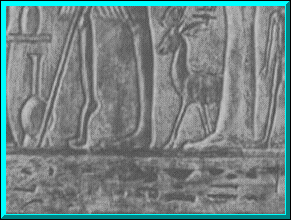| Polio has
probably always been with us. The oldest clearly identifiable reference to paralytic
poliomyelitis is an Egyptian stele or stone engraving over 3000 years old.1
Before the advent of modern sewage treatment, poliovirus was endemic in the water supply,
and most people probably were infected as infants, while they were still nursing, when the
mother's immune system protected them.2 In the late 19th
century, engineering projects were initiated in the industrialised nations to separate
human waste from drinking water. While these efforts helped control the spread of
diseases like cholera, it meant that children were not exposed to poliovirus until they
were older, long after their mothers' immunity had worn off. The result was
epidemics of poliomyelitis, or infantile paralysis. 
Detail of an Egyptian stele showing a priest
with a withered leg using a cane for support.
Poliovirus is an enterovirus. There are three serotypes: type I, called
brunhilde; type II, called lansing; and type III, called leon.3
It enters the body through the mouth, presumably when a substance infected with fecal
matter is swallowed, and multiplies in the lymph tissues of the pharynx and
intestines. A small amount of the virus travels through the bloodstream to other
sites, where it multiplies.4
In 80–90% of those infected, this is the limit of the disease. Those
infected suffer slight fevers, malaise, headache, sore throat, and vomiting 3–5 days
after they are exposed. They recover within 24–72 hours. This is called
abortive polio.5
The virus is dumped into the bloodstream again; its target this time is the central
nervous system, the spinal cord, and the brain.6 Even this
more serious form of disease may not result in paralysis, but the temporary affliction of
the central nervous system may lead to irritability, pain in the back and limbs, muscle
tenderness, and stiff neck.7
It is from this action that the disease gets it name. It is an
"inflammation (-itis) of the grey (poliós) anterior matter of the
spinal cord (myelós)."8
If the infection inflames the anterior horn cells of the spinal cord, the
motor nerves, temporary paralysis results. Recovery may take up to two years, and
may be incomplete; weakened muscles may be a permanent result.9
If the inflammation is severe enough to destroy the motor nerves, paralysis is
permanent. This is paralytic poliomyelitis.10
Only the motor nerves are affected by the polio virus; the sensory nerves
are not affected at all. Even if full and permanent paralysis results, sensation is
not diminished.11
The extent of paralysis is dependent upon how high up the spinal cord the
destruction occurs. If destruction is limited to the lower or mid-section of the
spine, various levels of paralysis will result. Destruction of the upper part of the
spinal cord, affecting the ability to breathe, is called respiratory poliomyelitis.
Destruction of bulb, or brainstem results in bulbar poliomyelitis, which impairs the
ability to swallow. Secretions may collect in the throat and cut off the airway,
strangling the patient.12
Once infected, there is no medical treatment, only physical therapies to
assist the body in surviving to fight the disease. In the 40s and 50s, rocking
tables were used to prevent the buildup of fluids in the lungs, which might lead to
pneumonia. Patients are isolated. At one time, before the poliovirus was
understood, isolation was meant to protect the uninfected; now we know it is more useful
to protect the patient against opportunistic respiratory infections.13
If the patient cannot breathe, a respirator is used. At one time, these were
iron lungs. Respiratory poliomyelitis may require a tracheotomy to prevent
strangulation.14


Footnotes
1. Dove, Alan. "A Brief History of
Polio." Polio Information Center Online. 1999. http://128.59.173.136/PICO/Chapters/History.html.
(8 May 1999).
2. Seavey, Nina Gilden (writer and director). "A
Paralyzing Fear: The Story of Polio in America." Oregon Public Broadcasting.
1998.
3. "Polioviruses." On-line Medical
Dictionary. 12 December 1998. http://www.graylab.ac.uk/cgi-bin/omd?polioviruses,+human+1-3.
(15 May 1999).
4. "Poliomyelitis." MedicineNet.
http://www.medicinenet.com/Script/Main/Art.asp?li=MNI&d=155
&cu=16583&w=0&ArticleKey=4972. (15 May 1999).
5. ibid.
6. ibid.
7. "Poliomyelitis." Encyclopædia Britannica.
15th Edition. Chicago, Illinois: Encyclopedia Britannica, Inc. 1980. p. 81.
8. Seavey, Nina Gilden, Jane S. Smith, & Paul
Wagner. A Paralyzing Fear: The Triumph over Polio in America. New
York, New York: TV Books, 1998. p 34.
9. MedicineNet. loc. cit.
10. Encyclopædia Britannica. loc. cit.
11. Dobrowolsky, Donna. "Polio." Saskatchewan
Awareness of Post Polio Society, Inc. http://www.sfn.saskatoon.sk.ca/health/polio/polio.html.
(27 May 1999).
12. Encyclopædia Britannica. loc. cit.
13. Seavey. "A Paralyzing Fear: The Story of Polio
in America."
14. Smith, Jane S. Patenting the Sun: Polio and the Salk
Vaccine. New York, New York: William Morrow and Company, Inc. 1990. |
